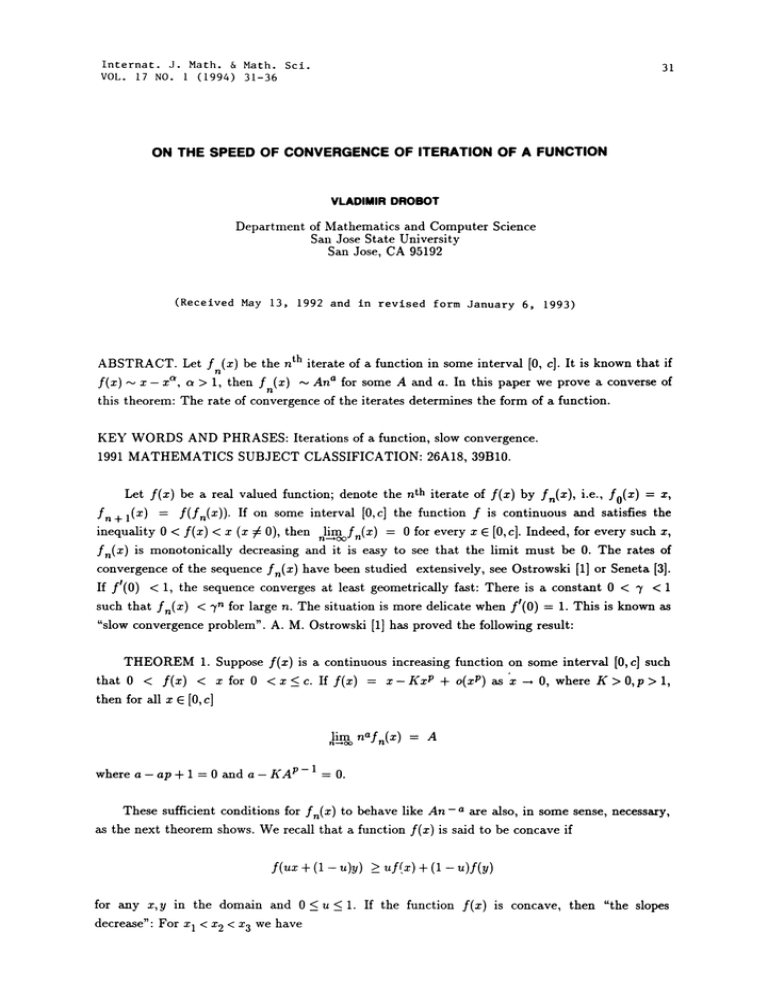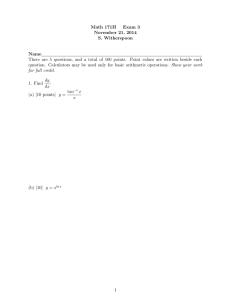fn(X) c,
advertisement

Internat. J. Math. & Math. Sci.
VOL. 17 NO.
(1994) 31-36
31
ON THE SPEED OF CONVERGENCE OF ITERATION OF A FUNCTION
VLADIMIR DROBOT
Department of Mathematics and Computer Science
San Jose State University
San Jose, CA 95192
(Received May 13, 1992 and in revised form January 6, 1993)
of a function in some interval [0, c]. It is known that if
fn(X) be the n th iterate
x- x c, a > 1, then fn(X)
An a for some A and a. In this paper we prove a converse of
ABSTRACT. Let
f(x)
this theorem: The rate of convergence of the iterates determines the form of a function.
KEY WORDS AND PHRASES: Iterations of a function, slow convergence.
1991 MATHEMATICS SUBJECT CLASSIFICATION: 26A18, 39B10.
real valued function; denote the nth iterate of f(x) by fn(X), i.e., fo(X)
x,
the
satisfies
and
the
function
is
on
some
interval
If
continuous
[0,c]
f(fn (x))"
f
0 for every x e [0, c]. Indeed, for every such x,
inequality 0 < f(x) < x (z 0), then nli_,mfn(X)
fn(X) is monotonically decreasing and it is easy to see that the limit must be 0. The rates of
convergence of the sequence fn(X) have been studied extensively, see Ostrowski [1] or Seneta [3].
If f(0) < 1, the sequence converges at least geometrically fast: There is a constant 0 < 7 <
such that fn(X) < .),n for large n. The situation is more delicate when f’(O) 1. This is known as
"slow convergence problem". A. M. Ostrowski [1] has proved the following result:
Let f(x) be
fn+
a
(x)
THEOREM 1. Suppose f(x) is
that 0 < f(x) < x for 0
then for all x E [0, c]
a continuous
<x_<c. Iff(x)
lim
increasing function on some interval [0, c] such
+ o(xP) as x O, where g>0,p>l,
x- gxP
na f n(X
A
wherea-ap+l=0anda-KA p-1 =0.
These sufficient conditions for fn(X) to behave like An -a are also, in some sense, necessary,
as the next theorem shows. We recall that a function f(x) is said to be concave if
f(ux + (1 u)y) > uf(x) + (1 u)f(y)
for any z,y in the domain and 0
decrease": For x < x2 < x3 we have
_< u _< 1. If the function f(x)
is concave, then "the slopes
32
V. DROBOT
(’"’2) f (’rl) > f (’r3) f,r (’r’2)
,r
.r
.r
2
3
2
For the proof see, for instance, Rudin [2].
THEOREM 2. Suppose f(x)is an increasing, continuous, and concave function on [0, c]
satisfying 0 < f(x) < x (x 0). Suppose also that for some fixed a > 0, 1,i_mnafn(z exists and is
different from 0 for every x E [0, c]. Then for every > 0 there is ct > 0 such that
z-xP-< f(.r) <
where a-ap +
0, i.e., p
.r-zv+,
for0
<
z
< c,
+ 1/a.
We need the following lemma.
LEMMA. Let 0 < V < v and let g(z) sx- L be a linear function with slope 0 < s < such
that g(v) V. Let w be the number such that g(w) w and let w < z < v. Put
N
N(v,V,s,z)=
log(z + 1-s
log(s)
Ifk>Nthengk(v) < z, and if k > N then gk(v)
PROOF. Put
v
V
v- g(V) and
tk +
s
> z.
gk(v)
k+
[gk-1 (v)
gk
gic + l(V), k
1,2,.... Then
(V)]
and so
t+t2+...t =t(l+s+s2+... +s-)= t
-ss =v-V
=v-Vl-V(1-slc)
-s
v-Vsic
+v
1-s
1-s
But then
gk(v)=v-(tl+t2+... +tic)
v-V
1-3"
This is a decreasing sequence in k, hence gic(v) < z is equivalent to k > N, and gic(v) > z is
equivalent to k < N.
PROOF of Theorem 2. It is enough to show that, under the hypothesis of the theorem,
lim
-.0+
log(x- f(x))
og()
r’
+ 1/"
(1)
We break the proof into two parts: I. lim inf _> p, and II. lim sup < p.
Proof of I. Let
lim inf and assume that < p. We notice, by the way, that _> 1 because
Ilog(x f(x)] > log(x) for 0 < x < 1, and p > 1. Thus there exists a sequence c > x > x2 _>...
0 such that
SPEED OF CONVERGENCE OF ITERATION OF A FUNCTION
log(xt f(xt))
log(xk)
-
.f(xt)
c, hence Ilog
increases as k
{xt} satisfies
stl
()
t--. < p.
f(z)/x
Since the function f(x) is concave and f(0)= 0, the ratio
From (2) it follows that f(xt)= x t a" t and thus
1-x
st=--
33
is a decreasing function of x.
tt,t
decreases as k--o. We may thus require that the sequence
logxt+ >
logs
2
t+l
log xt
logsk
and
log xt
> k
(3)
g sk
1-z-1.
If
Let k be fixed. The slope of the line joining (0,f(0)) and (zt: f(zt) is equal to s
function
x > zt, then the slope of the line joining (zt, f(zt) and (z,f(z))is less than s (the
f(z) is concave), hence f(z) < stz for z > z t. Define function g(x) by
g(x)=stx
if
xt<x<Xt_l,k=2,3,
We have just proved that f(x)< g(z), so fro(x)< gin(x) for all integers m (f is monotone, i.e.,
/m(x) f(f m- (x)) -</(grn- (x)) -< gm(x))" Let n k be the smallest
12(z) <_ f(g(x))
integer such that gn,(Zk_l)<Zt. We apply the Lemma with v=zk_ l, V= f(zk)
t,_
xk’ s= V/v. A simple calculation leads to
Xk- X k_
log x t -log xt_
log s t
nt <
+
(4)
1.
We remark that if y < xk_ then gnt,(y < x k. Indeed, if y < xk, the result is immediate since
g(x) < x; if x k _< y < xt_ 1, then gn(Y) < xt for some n < nk, so
(gn(y)) < xk" Thus
fn2(zl)
f n + n3(l)
- < gn2(X) _<
n 2 + n 3 +...
Setting N k
implies that for any b > 0
+ nt,
x2
9n3(f n(zl))
fn+n3+... +n(Zl) --< gnt(fn+’’"
gnu:-n
(5)
x3
+nt-,(Xl)
the last inequality in
_( z k.
(5) becomes f N(Xl) <_
N k fN:(Xl) <_ N k x k.
(6)
By hypothesis of the theorem, if b > a then the left side of (6) goes to
the desired contradiction we will show that the right hand side of
b > a. We now estimate N t. From (4) we obtain
t
k
Nk
nm
=E
m=2
=k
logx, logx,_
+E
1ogsm
m=2
x k, which
(6)
< k +
as k
.
To obtain
goes to 0 as k---,cx for some
._.
/:
m=2
log
go-
(7)
34
V. DROBOT
However, the requirement (3) gives
log.r k_l
llgxk
< 2logs
logs k_l
k
log "1,.-2<1 log xk_
[_1__’2 log x k
<
2 logsk_l
\2] logs k
logs k_2
logs2
< 2logs <
3
<
logs k
Substituting these in (7) we obtain
Nk <
k
log xk
k+m=Y]2 (1/2)m--1 logs
k
log z
log z
log x
< logs k
k
3logskk
+2logskk
the last inequality being justified bu (3). It is thus sufficient to show that for some b > a
b
lim
zk
O,
/gg )
or, what comes to the same thing
lim
x/b log z
k--.oo
Now,
k
k_
1 is monotonically decreasing to t-
(8)
0.
log s k
(see (2)), hence
k
1
< t- 1 + e for arbitrary
and k sufficiently large. Thus
1-xk-I <l-xk-l+e
-
or
Ilog ski
log (i
z
SO
*
)l > Ilog (i
+
x k log xk
log x k
<
+
log s k
k
log (1
k
x
for arbitrary e and k sufficiently large. To establish
exists e > 0 and b > a so that
lim
-0 +
where
< 1 + 1/a. Since log(1 + u)
x
og (:
u as u
(8)
it is sufficient now to show that there
log x
’-’ + )
0, the expression in
2z’/’ +’ -’- log(z)
(9)
0,
(9) is less than
(10)
SPEED OF CONVERGENCE OF ITERATION OF A FUNCTION
35
for sufficiently small x. But < +(1/a hence there is > 0 such that
+{1/a}- > O, and
so for some b > a the exponent in (10) is strictly positive, i.e., (9) holds (zrlogz -’ 0 for any
r
> 0). This proves I.
>_
Proof of II. Again, we argue by contradiction. Assume that there exists a sequence c > Xl
0 such that
x2 _>...
log(- f())
log(zk)
(11)
t> p.
k
Without loss of generality we may assume that
(12)
+
(xk--Zk+l)
It follows from (11) that
f(xk)
x
(13)
(14)
Zk+l
k
xt.
xk
>_
,+.
Let h(x) be the function defined by
f(zt)
if z z t
z
if z t +
ifz=0
-<
linear
0
< zt
Since the function f(x)is concave, we see that f(x) > h(x) and so, as in the proof of part I,
]m(x)>hm(z) for all integers rn. Define two integers n t and rnt as follows: nt is
the largest integer such that
> xt+ and m t is the largest integer such that
hnt(xt)
hm(Xt)
V
x
k
1/2 (xt + zt + 1)" We now obtain estimates on mt using the Lemma. In this case v
z 1/2 (Xk + Xk + l), and
>
s
f(x’t) f(xt4-1)
tk +
Xkmt --Xk+
-:t/l
1
Xk-Xk+
sk
Applying the Lemma, we obtain
log
1/2(xt + xt + 1) +
x
mt >
xk
-__t-+xk -Xk+l
tl
log x t
t
log s t
After direct simplification this reduces to
m
t>(logst)-llo 1/2
We apply (13) and the fact that s t
mk
+xt+l
to obtain
>--
Cl
sk
t, +1
xk --Xk+l
Cl
Xk xk +
t+
t
xk Xk +
-1.
-1
zt,
36
V. DROBOT
for large k, where c is a constant. Finally, from (14) we obtain
,. z
>_
c2
-t k
(15)
for sufficiently large k, where c 2 is some constant. For k
+ nk- + mk" It follows from the definition of n’s and m’s that
h(x) > 1/2 (x k + x k + l)
>2
set
Nk
=n
+n2+.
-1/2xk
hence for b > 0 we have
Nk
fNk(Xl) > NI hNk(Xl) > 1/2 NI x
(16)
k
b
Since nafn(Xl) converges to a limit that is different from 0, it follows that as k --, oo, N k f, (Xl)
oo whenever b < a. Fro(15)
0 as k
0 if b < a. But Nk > mk, so (16)implies that
we see that
mbuxk
m
k
Xk >
c2x(1-tk)+l
(17)
Now, 1 + 1/a < k so a(1- tk) + 1 < 0, and thus b(1- tk) + < 0 for some b < a and k
oo. This contradiction completes the
sufficiently large. We see from (17) that for such b, mkx k
proof.
A word or two regarding the concavity assumption in the Theorem 2. The assumption is
certainly needed in the proof. The result is also not true without it. The idea is this: Construct
0 at an arbitrary rate. It is easy to see that one can
an arbitrary sequence 0 < Xn < 1, Xn
construct a function f(z) such" that f(1)= z and f(zn)= Xn+ (Just draw a picture). The
values of f(x) at other point can be taken completely arbitrarily so that the conclusion of
Theorem 2 need not hold.
REFERENCES
1.
OSTROWSKI, A.M. Solutions of Equatioas i_n Euclide.aa And Banach Spaces. Academic
Press, New York, 1973.
2.
RUDIN, W. Real and (omplex Analysis, McGraw-Hill. New York, 1966.
3. SENETA, E. On Koening’s ratio for iterates of real functions, J. Australian Math. Soc.
10(1969), 207-213.







